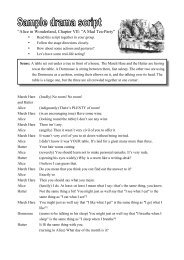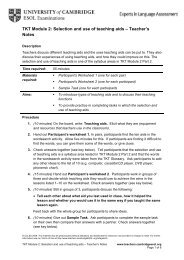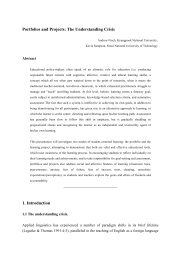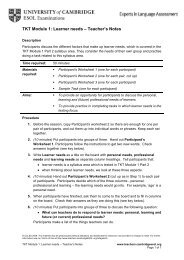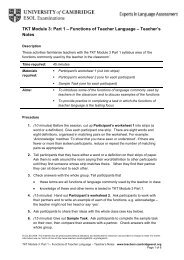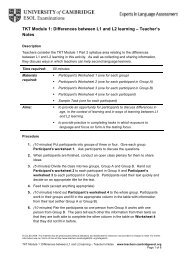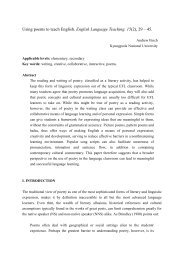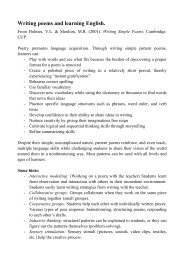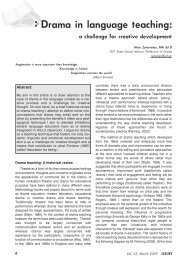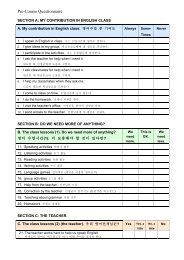here - Finchpark
here - Finchpark
here - Finchpark
You also want an ePaper? Increase the reach of your titles
YUMPU automatically turns print PDFs into web optimized ePapers that Google loves.
Korean Embassy Seminar, August 29 th 2008, NottinghamKorean Schools in the UK: Issues and RecommendationsDr. Andrew FinchAssociate Professor, Kyungpook National University, Department of English EducationVisiting Research Fellow, University of Bristol, Graduate School of Education1. Heritage Language LearningHeritage Language Learning (HLL) and HL instruction are becoming important new fields offoreign language (FL) education (Kondo-Brown & Brown, 2008, p. ix). They are especiallysignificant because they recognise a new social context for language learning. Instead of learning aforeign language in order to pass an exam, go to university, study in another country, or obtain agood job, HL learners are studying the language of their ancestors, while living in another country.HLL is t<strong>here</strong>fore not just about language learning. It includes the culture, values, beliefs and ideasof the learners’ parents, grandparents, and society as a whole.HLL has many shapes and forms. This is because it reflects the various conditions existing in ethniccommunities living outside their original homeland. At first, when HL instruction was recognised(in the 1980s) HL learners were the children of foreign-born parents who had newly arrived in theUSA or Canada. The first-learned language (L1) of these children (e.g. Korean - the ‘mothertongue’ or ‘first language’) was gradually giving way to the new dominant language (e.g. English)of the country in which they were living, and the purpose of HL instruction was to preserve andmaintain the use of the L1 by the children. (VCLA Steering Committee, 2000; Valdes, 1995, 2001).This early version of HLL was based upon the assumption that the parents were immigrants to the‘host’ country and intended to settle down t<strong>here</strong>. Since that time, however, HLL has expanded, andthe definition of HL learners now includes the following cases:i) Children of parents who are visiting the host country for a short time.○ Parents might be international students or academics, workers in foreign branches ofcompanies based in the mother country, or public servants dispatched overseas(diplomats, embassy staff, etc.).○ The length of stay might be anything from a few months to a few years.○ The children of these parents are often very young, knowing little of the ‘mother tongue,’and not having been educated in the mother country.○ In this case, bilingual acquisition of the L1 and the HL is common.○ Parents (and children) intend to return to the mother country sooner rather than later.ii)Children who were born in the host country, and for whom the ‘mother tongue’ is English.○ This ‘1.5’ generation often speak different a L1 to their parents with resulting identityand communication problems.○ They wish to learn the heritage of their ancestors through the HL, thus establishing theirown identity in a multicultural world.○ They often intend to stay in the host country, at least until graduation from university.○ They are often learning a second language (e.g. French, German, Spanish) at state school,and are becoming multilingual as well as multicultural.More variations on these themes can easily be imagined, as internationally job mobility becomesnormal, and as the ethnic communities become more established in the host countries. Rather than
having to acquire the language of the new country, like their immediate parents or grandparents,future 2 nd , 3 rd , 4 th (etc.) generation HL learners will be eager to learn the cultural mores of theirforebears. In this shift from ELT to HLL, learners will be attempting to discover the culture-specificvalues and ideas of their ancestors. They will be acquiring the ‘mother language’ in order to explorethe ‘home’ community's social structures and beliefs (Shin, 2005).In view of these new developments, it can be seen that socio-cultural aspects are extremelyimportant in HL education. This agrees with current socio-linguistic approaches to languageteaching, in which language development is understood to have many interconnected contextuallayers, along with various psychological and cultural factors. HL instruction must, t<strong>here</strong>fore, takeaccount not only of the language that is being learned, but also cultural and social issues of identity,ancestral culture, family relationships, and emotional learning (self-esteem, confidence, motivation,attitudes, anxiety, etc.).As can be seen, t<strong>here</strong> are many considerations to take into account when devising a HLL curriculumand designing HL textbooks and learning materials. Educators, policy makers, and parents need toask a number of important questions:1. Curriculum: How can the curriculum meet the linguistic and situational needs of all thelearners?○ What differing learning needs do the learners have?2. Goals and objectives: How well can the curriculum goals and objectives match theperceived needs of the HL learners?○ How can the objectives be formulated, sequenced across levels, and integrated acrossthe reading, writing, listening, and speaking skills?3. Assessment: How can the diagnostic, progress, and achievement tests/assessments providefeedback on the HL learners’ abilities to perform the objectives at various points of time?4. Textbooks: How can textbooks and teaching materials match the objectives and thecurriculum as a whole?5. Teacher-training: What teacher development and support policies are needed?6. Formative planning: How can the entire curriculum be revised and improved?7. Support: What sort of support (financial and otherwise) is needed from the ‘home’ Embassy,the ‘home’ government, the ‘host’ government, the parents, and the local community?(Adapted from Kondo-Brown & Brown, 2008, pp. 7-8)1. BilingualismBilingualism is a fact of life for the majority of the world's population. It is estimated that abouttwo-thirds of the world's population is bilingual (Baker & Prys Jones, 1998). T<strong>here</strong> are anyw<strong>here</strong>between 5000 and 6000 languages in the world today (Crimes, 2000) and only about 190 countriesin which to house them (World Almanac, 2003), which indicate how widespread language contactwithin individual countries must be. Although the ability to use two or more languages is, t<strong>here</strong>fore,more common than monolingual competence (Mac key, 1967), bilingualism has traditionally beentreated as a special case or a deviation from the monolingual norm (Romaine, 1995: 8). Mostlinguistic research has tended to focus on monolinguals and has treated bilinguals as exceptions.Compared to other language-related disciplines, bilingualism is a relatively new field of study andcurrently rather poorly understood. Systematic studies of childhood bilingualism, in particular, areseverely lacking compared to studies of the development of monolingual children. We currentlyknow relatively little about why and how some children become bilingual while others do not.Much more research would be required of different groups of children who take different routes tobilingualism in childhood and ways in which their bilingualism is perceived and valued in different
ways. This chapter highlights what I see as most salient and also most problematic in the study ofbilingual children. Any research into the bilingual development of children must not only entail thelinguistic, pragmatic and cognitive development of children but also needs to be firmly rooted in itssocial and cultural context. However, as we shall see, much of the available research on childhoodbilingualism is limited in scope - for example, studies often treat children's bilingualism as purely aphenomenon of language acquisition and give little regard to the social context in which the twolanguages are acquired (De Houwer, 1995; Genesee, 1989). In addition, few studies preciselydescribe their subjects' linguistic history or exposure patterns, which are necessary for cross-studycomparisons (Schieffe1in, 1994).2.1 Simultaneous bilingual acquisitionThe earliest systematic studies of simultaneous acquisition of two languages were those by Ronjat(1913) and Leopold (1939-49), who raised their children bilingually. Ronjat introduced the "oneperson-one language" principle as the most effective method for raising a child bilingually in ahome w<strong>here</strong> the parents have different mother tongues. Following this approach, Leopold studiedthe acquisition of English and German by his daughter Hildegard by keeping a diary of Hildegard'sspeech until she became two years old. In the home, Leopold spoke only German to his wife andHildegard, while his wife spoke only English. Leopold claims that Hildegard had one linguisticsystem (i.e. did not separate the two languages) and did not associate the languages with specificpersons even though her parents spoke to her in different languages.Research evidence has now been growing in favor of the hypothesis that a child's two languagesdevelop separately from the very beginnings of speech production. Several studies have shownthat bilingual children use the two grammars differently as soon as t<strong>here</strong> is evidence of grammar(Dbpke, 1997; Paradis & Genesee, 1996; Pfaff, 1992, 1994). Furthermore, the claim that bilingualchildren start out with a single, undifferentiated lexicon is challenged by recent studies that showthat bilingual children have a fairly stable rate of translation equivalents (words used in onelanguage that correspond to words with equivalent meaning in the other language) as soon as theybegin talking (Pearson et al., 1995; Quay, 1995). In addition, t<strong>here</strong> is now evidence that bilingualchildren acquire pragmatic knowledge even before showing lexical differentiation (Nicoladis,1998).2.2 Successive bilingual acquisitionUnlike simultaneous bilingual acquisition, studies on successive bilingual acquisition have oftenbeen carried out in the field of second-language acquisition (see Klein, 1986; Larsen-Freeman &Long, 1991; Gass & Selinker, 2001 for introductory literature). However, second-languageacquisition research has traditionally dealt more with adult language acquisition than with childlanguage acquisition (Romaine, 1995) and t<strong>here</strong> is currently a severe shortage of systematicstudies available in successive bilingual acquisition in childhood.2.3 Effects of Bilingualism on the ChildA great deal of research has shown that t<strong>here</strong> are many individual and societal benefits ofbilingualism. For example, bilingualism develops cultural diversity in societies; it promotes ethnicidentity and intergenerational relationships; it leads to social and cultural adaptability and adds tothe mental health of the child (Baker & Prys Jones, 1998; Crystal, 1987). Becoming bilingual hascognitive advantages for the learner and results in superior scholastic achievement (Cummins,1996; Krashen, 1998). A large number of studies (e.g. Bialystok, 2001; Cummins & Swain, 1986;Hakuta & Diaz, 1985), most of which investigated children's explicit knowledge about thestructure and functions of language itself, have reported that bilingual children exhibit a greatersensitivity to linguistic meanings and may be more flexible in their thinking than monolingual
children are. However, not all research shows the positive effects of bilingualism. Before 1960,t<strong>here</strong> were an overwhelming number of studies that highlighted the negative effects ofbilingualism on children (see Grosjean, 1982: 220-27; Romaine, 1995: 107). Observers notedmany problems with language development of bilingual children, such as restricted vocabularies,limited grammatical structures, unusual word order, errors in morphology, hesitations, stuttering,and so on. Some have even argued that bilingualism could impair the child's intelligence and leadto split personalities. How can these contradictory findings be explained?In a comparative analysis of selected studies, Swain and Cummins (1979) report that the positiveeffects are usually associated with language majority children in immersion programs, w<strong>here</strong>knowledge of two languages is valued highly, w<strong>here</strong> the children learn the L2 without losing thefirst and w<strong>here</strong> the parents are of relatively high socioeconomic status. For example, middle-classEnglish-speaking parents in Canada who enrol their children in French immersion programschoose to do so because of the perceived benefits of knowing another language. The educationalgoal of such programs is the enrichment of children from the dominant group through instructionin a second language. The children's L1 (English in this case) is respected and is in no danger ofbeing replaced by the L2 (French). Teachers in immersion programs have high expectations forchildren's achievement and t<strong>here</strong> is usually a significant level of parental involvement and support.French is considered a valuable addition to the children's existing linguistic repertoire and the mostusual outcome is proficiency in both English and French. This type of bilingual developmentcorresponds to Lambert's (1977) 'additive bilingualism'.In contrast, negative effects are found with linguistic minority children who are forced to learn themajority language and are not encouraged to maintain their mother tongue and whose socialenvironment does not induce learning. The bilingualism of linguistic minority children is differentfrom that of linguistic majority children because the home language is not supported in school andthe society. Minority children usually experience enormous pressures to learn the societal languageand feel that they need to give up their L1 in order to be accepted by the mainstream society. Inschool, the bilingualism of linguistic minority children is considered a handicap, and children'sprior linguistic and cultural knowledge is deemed irrelevant or undesirable. The message given bythe educational and social establishments is that immigrants need to be rapidly integrated into themainstream society, which entails abandoning the ethnic language and culture. It is small wonderwhy so many immigrant children end up losing their mother tongue and become monolingual inthe societal language. This situation corresponds to Lambert's (1977) 'subtractive bilingualism'.4. Literature ReviewMany issues involvedStudies concerning HL acquisition and instruction have become a sub-discipline in the field ofapplied linguistics, a sub-discipline w<strong>here</strong> the researchers examine the linguistic, pedagogical,social, and political issues related to HL learners (e.g., Kondo- Brown, 2003, 2005; The UCLASteering Committee, 2000; Valdes, 1995,2005; Webb & Miller, 2000).In the 1980s and early 90s, the personal benefits of HL development for students with immigrantbackgrounds were widely discussed in educational research. For example, the US.-based researchon students from immigrant backgrounds suggests that HL development is interconnected withpositive ethnic identity development and academic success (e.g., Delgado-Gaitan & Trueba, 1991;Gibson,1988; Golden, 1990; Nielsen & Lerner, 1986: Trueba, Cheng, & Ima, 1993; Portes &Rumbaut, 1990). Likewise, earlier Canada-based studies about the educational outcomes of HLdevelopment are positive, suggesting that HL development may actually help language minority
children learn the dominant language and improve their overall academic achievement (Cummins,1981a, 1983; Cummins & Danesi, 1990; Danesi, 1986).4.1 Community-based HL schoolsCommunity-based HL schools were established primarily by immigrant parents, often affiliatedwith religious organizations (see Byun, 1990; Shin, 2005; Wang, 2003). Some of these schools arenon-profit and others are for-profit offering weekend, after-school, or summer programs. T<strong>here</strong> areover one thousand Korean schools (Shin, 2005) in the U.S. alone, contrasting with the 20 KHLschools in the UK.Some studies (e.g. Kondo, 1997; Kondo-Brown, 2004) investigated the relationship betweendemonstrated HL proficiency levels and length of instruction at community-based heritage schools.However, these studies failed to detect a positive correlation between proficiency levels and lengthof instruction at HL schools. In Sohn and Merrill's (forthcoming) study, the 4th and 5th grade KHLlearners' proficiency levels did not appear to be associated with their attendance in communitybasedKorean schools w<strong>here</strong> the students study Korean for two or three hours each week. InKondo-Brown (2004), the predictive power of instruction variables (years of attendance to communityJHL schools, years of high school Japanese) turned out to be weak and non-significant.T<strong>here</strong> seems to be no exploratory study that examines the relationship between Japaneseproficiency levels and the length of attendance at hoshuukoo. However, Chin en and Tucker's study(this volume), which was discussed earlier, suggested that hoshuukoo may play an important role inJHL learners' Japanese proficiency development. The study indicated that attitudes towardhoshuukoo are related to self-ratings of their Japanese proficiency as well as their degrees ofJapanese ethnic identification. In Kanno, Hasegawa, Ikeda, Ito, & Long (forthcoming), 15 universitystudents of Japanese (including JHL learners), who were either advanced or superior levelson the ACTFL OPI scale, took various oral and written tests. Descriptive analysis indicated that thethree students who were judged to be "balanced" bilinguals with superior accuracy and complexityon oral and written tests were all hoshuukoo graduates.Correlational and regression analysis studies did not identify a relationship between HL instructionand achieved proficiency levels in Japanese or Korean (e.g., Sohn & Merill, forthcoming; andKondo-Brown, 2004). Three studies (Ching & Kung, 1997; Lao, 2004; Lepore, 2004) with Chineseparents also suggested a limited role for formal HL instruction in developing Chinese proficiencydue to limited hours, attitudinal problems, and other problems. For example, interviews with USbasedChinese immigrant parents (N=16) in Ching and Kung's (1997) study suggested that theparents perceive a limited role for Chinese schools in developing Chinese proficiency for variousreasons (e.g., insufficient class hours, little at-home reinforcement, children's attitudinal problems).These parents felt that (a) the primary and important role of Chinese schools is to maintain ethnicidentity, and (b) a loss of Chinese proficiency will not necessarily lead to the loss of ethnic identity.Similarly, as part of Lepore's (2004) case study, parental views of the role of the Minnesota-basedChinese schools were examined based on interviews from multiple sources such as students,parents, teachers and school administrators (a total of 19 individuals). Qualitative analysissuggested that parental expectations about the learning outcomes at Chinese schools seemed to varyconsiderably, but were generally low.Lao's (2004) questionnaire survey study of a preschool Chinese-English bilingual program in SanFrancisco also suggested that the parents saw limited impact from a HL program on Chineseproficiency development. The participants were 86 parents whose children were enrolled in abilingual program. The study indicated that the main reasons for encouraging English-Chinesebilingualism were practical advantages, positive self-image, and improved communication with the
Chinese-speaking community. Lao’s study found a gap between the proficiency levels expected byparents and the actual performances of their children. It also found that the parents felt that theirlimited use of Chinese and the lack of other family resources were contributing factors to this gap.On the other hand, two case studies with Japanese parents (Shibata, 2000; Siegel, 2004) suggestedthat these parents saw an important role for Japanese schools in their children's Japanese languageeducation. Shibata's (2000) case study of one Japanese immigrant family examined how the family'sefforts at raising bilingual children were assisted by a community-based Saturday Japanese school,located in a small city with "low ethnolinguistic vitality.” In Siegel's (2004) study, two Japaneseimmigrant mothers, whose children attend a newly established JHL school in Arizona, wereinterviewed. The data describe parental views of their children's experiences in the after-schoolprogram (every Friday, 40-50 minutes).Shibata (2000) and Siegel (2004) suggested that Japanese parents support Japanese languagemaintenance and believe that Japanese schools play an important role in Japanese language andcultural maintenance, and serve as a place for socialisation with other JHL learners.Tse (1998b) reviews available studies comparing ethnic minority students who haveexposure to HL programs and others who do not. She concludes that HL programs have apositive impact on language attitudes in most studies, suggesting beneficial outcomes fromexposure to and/or instruction in the language. The subjects reported greater appreciation ofthe HL, confidence in using it, enjoyment in doing schoolwork in the language, and a desire tocontinue learning it. In addition, exposure to HL programs promotes a positive association andcloser identification with one's own ethnic group. In addition, all of the successful HLspeakers in Tse's (2001) study had enjoyed the institutional support provided by schoolapproval of the HL, either in the community or through their mainstream schools. The positiveexperiences primarily centreed around experiences w<strong>here</strong> teachers and/ or classmates valuedthe language ability the participants brought with them from home.Tse (2001) found that each participant saw their HL as being highly vital (useful and evenprestigious) and had (1) a peer group that used the HL; (2) contact with institutions that valuedthe language; and (3) parents who spoke the HL and encouraged its development. Amongthese, having a peer group who values the HL was the most critical. At some point in theirlives, each participant became part of a peer group who valued the HL. Possessing HL abilitywas critical for gaining access to, getting full membership in and/ or achieving a prominentposition within the particular social group. A second base of support that boosted theparticipants' opinions of the HL came from formal institutions that valued HL proficiency. Inall of the cases, learning the HL began with exposure to language and literacy experiences inthe home and community at an early age. For all of the participants, this linguistic foundationwas available through adolescence and early adulthood, when proficiency in the languagebecame more important for school, career, and/ or identity development.T<strong>here</strong> are currently over one thousand Korean HL schools in the United States, most ofwhich are organized and operated by Korean Christian churches. Many of these programs aresmall and offer a limited selection of courses. One of the major concerns of these programs isa lack of texts that are written specifically for heritage learners of Korean. Much of theinstructional materials that are currently used in Korean HL schools in America have been'donated from Korean embassies and have been formatted for Korean learning styles andlifestyles that are foreign to Korean American children' (Lee, 2002). T<strong>here</strong> is also a generalshortage of age-appropriate texts for older beginners (i.e. secondary school students andadults), who are put off by the childish content in many beginning Korean texts. Bookswritten for second-generation Korean Americans about Korean culture and history and theKorean immigrant experience are also very much in need (but see National Association for
Korean Schools, 2002).Another major concern of Korean heritage schools is teacher development. Due to limitedresources, teachers are usually paid minimally and receive little adequate professional training.Many programs suffer from a high teacher turnover rate, which adds to the problem of staffdevelopment and training. Most teachers in Korean HL schools have been educated in Koreaand teach in the way in which they have been taught - a great deal of instructional time isspent on rote learning, drills and memorization. As a result, most heritage learners, who areaccustomed to an instructional method that encourages student participation and creativethinking, find much of the instruction in Korean schools tedious and unproductive. Koreaneducatedteachers and American-educated students hold different expectations of whatconstitutes acceptable student behavior in the classroom. For example, Korean-educatedteachers see themselves as primary transmitters of knowledge and expect students passively toabsorb materials taught in a largely lecture-style manner. Few teachers are familiar withtechniques for eliciting student input and organizing and supervising group activities, whichare especially important in language classrooms. Teachers may also feel threatened bystudents who ask too many questions.The collision of learning and teaching styles in the HL classroom calls for a teacherrecruiting strategy that specifically targets the so-called '1.5generation' Korean Americans.These are individuals who have the bilingual and bicultural capacity to 'go between' theKorean-speaking first generation and the English-speaking second generation. Most 1.5-generationers were born in Korea and came to the United States during school age and havebeen educated in both countries. Since they are familiar with both styles of teaching and havefirst-hand experience in cultural adaptation, 1.5-generationers can provide useful insights tothe development of curriculum materials that are geared specifically for second-generationKorean Americans. Since they are bilingual, they can explain grammatical concepts in Englishand act as cultural mediators between parents and children. Of course, 1.5-generation teachersshould be supported to further develop their literacy skills in Korean and trained in effectivelanguage teaching methods. One promising option for heritage teacher development is a threewaymodel in which first-generation teachers and l.5-generation teachers work collaborativelywith university-level teacher-training programs. This type of model enables the provision ofprofessional development that is specifically tailored to meet the needs of both groups ofheritage teachers who mayor may not be English speaking. Teachers may learn about studentcentreed,theme-based language-teaching methods that raise awareness of language use aswell as classroom management techniques (see also Schwartz, 2001).4.2 SocialisationTo understand, prevent, and reverse language shift in language-minority families, one must firstunderstand the socialisation processes through which young children initially acquire their HL.With this knowledge, we can provide optimal environment for heritage learners in the home,school, and community.The concept of language socialisation is both "socialisation through the use of language andsocialisation to use language" (Schieffelin & Ochs, 1986, p. 163). Children become competentmembers of their community by participating in language socialisation activities (Ochs &Schieffelin, 1984, 1995; Schieffelin & Ochs, 1986) -linguistic interaction between a novice and anexpert, usually, but not exclusively, a child and caregiver - internalizing social speech that is sharedwith them by community members The internalized dialogue - "inner speech" - structures andrestructures how children perceive and interpret the world around them (Vygotsky, 1978) and
control their behavior, values, and morals (Tappan, 1997). Through language socialisation practices,cultural values and language are transferred to the next generation.Also transmitted through this socialisation process are language ideologies: community members'beliefs regarding a specific language or features of language, speakers of language, production oflanguage, teaching and learning of language, and interpretation and understanding of language.Community social structure have been linked to community members' linguistic behaviors(Woolard & Schifelin, 1994). Language socialisation research attempts to understand how languageideologies are reflected in the community members' use of language, particularly with and aroundchildren. Children assume an active role in language socialisation (Giddens, 1979; Ochs, 1988).Immigrant families often observe that children socialize their immigrant parents, who may have lesscontact with the dominant language and culture, into their own school experiences (Ochs, 1986). Inmany language minority families, children's use of English at home increases once they enter school(Shin & Milroy, 1999), and parents start using English with their children, often believing that theyare helping to improve their children's academic achievement (Shin, 2005).Investigating children's language socialisation patterns will increase understanding of the intricaterelationships between cultural ideas and linguistic practices. However, few studies address languagesocialisation of bilingual children in the United States (He, 2001; Smith-Hefner, 1999; Zentella,1997), and no studies have dealt with how young Korean-American children are socialized throughHL use. Studies of Korean-English bilingual children have focused exclusively their usage patternsof English versus Korean (cf. Baek, 1992; Min, 2000; Oh, 19l Shin, 1998,2005; Yoon, 1996). Thisstudy examined how language ideologiesFrom a language socialisation perspective, He's (2001) ethnographic discourse analysis studyprovided evidence that Chinese school classrooms can serve as important language socialisationsites in which child CHL learners are becoming competent members of the Chinese language andculture. He's (2001) study was situated in four different classrooms at two Chinese schools in theU.S. He examined how CHL children (aged 4.5-9, N=35) would develop communicative patternsto express "ambiguity" through socialisation. He's analysis indicates that ambiguous utterances -syntactically and semantically - are interpreted/communicated by the participants (native teachersof Chinese and HL students) through pragmatic inferences available in the givenclassroom/interactional contexts.4.3 IdentitySome studies have suggested an association between HL proficiency and identity development(e.g., Chinen & Tucker, this volume; E.J. Kim, this volume; Kondo, 1997; J.S. Lee, 2002; Oketani,1997a). A person's idea of self is socially constructed, resonating the ideologies of the society towhich he/she belongs (Mead, 1932; Schieffelin & Ochs, 1986). The perceptions and definitions ofself differ according to each society's basic beliefs and ideologies. How a person presents his/herself to the public is determined by the culture-specific concept of self (Goffman, 1955).Definitions and perceptions of self are one of the distinguishing features between Western andEastern ideologies. R. Brown (1996) argues that in the East, the self “is said to be relational,interpersonal, or collective w<strong>here</strong>as the self in the West is individualistic and autonomous” (p. 39).Clear relationships exist between the concept of relational self and linguistic forms in Asianlanguages such as Javanese, Japanese, and Korean. When interacting linguistically, speakers ofthese languages express their social identity in relation to others, highlighting the relational aspectof self (e.g., hierarchy). Failure to indicate the relational hierarchy with appropriate linguisticfeatures is regarded as rude, ignorant, and resistant to the societal order. Thus, knowledge about thecultural concept of self is essential for culturally effective and polite interactions.
The public side of self, called face, is "the positive social value a person effectively claims forhimself by the line others assume he has taken during a particular contact" (Goffman, 1955, p.319). In other words, face is an aspect of self that a person presents to others with the expectationthat they will perceive and interact with this aspect of self according to shared value systems.Universally, adults socialize children through how they treat and react to the children's and otheradults' faces; however, positive social values differ across cultures and, consequently, the concept ofself, including face, are culture specific.4.4 Intergenerational TransmissionIntergenerational transmission of HLs is the most effective way to preserve and even revivelanguages (Fishman, 1991; 2001d; Skutnabb-kangas, 1988). Grandparents are thus potentially greatresources for children to acquire, maintain, a develop their HL proficiency and knowledge ofheritage culture. In immigrant families, grandparents are often the primary reason for using HL inthe home Parents almost exclusively use HL with their own parents (the children's grandparents)(Shin, 2005), and they want their children to do the same. Children also think they should use HLwith their grandparents (Kanazawa Loveday, 1988; Wu, 1988).Previous studies found that children's HL proficiency has a positive correlation with theirrelationship with their grandparents: the closer the relationship the better their language proficiencyand vice versa (Sridhar, 1988; Wu, 1998). Similarly, when children lose their HL, they have moredistant relationship with their grandparents (Schmidt & Padilla, 19~ Silverstein & Chen, 1999).The values and morals of heritage culture are conveyed through transmission, of its language.Similarly, the use of the Korean language transfers the concepts politeness to the next generation;in particular, Korean children internalize how indicate hierarchical relationships to expressdeference and respect while learning the appropriate use of honorifics. Thus, when language shiftsoccur in Korean American families, not only do parents lose the means to socialize their childreninto competent members of the Korean community, but children also lose the toe to express theirrespect and deference in appropriate Korean tradition. Shin (2005) stated that Korean-Americanswho cannot use honorifics properly are regarded being "not genuinely Korean" (p.65).A study (Jo, 2001) suggested that KHLLs have great difficulty in learning the complex Koreanhonorifics, and suffer from discrepancies between “standard/academic” versus“marginalized/parental” varieties of Korean pronunciation, vocabulary, and grammar. Jo alsopointed out KHLLs’ potentially poor spelling due to their habits in writing the oral version ofKorean, an issue that has been largely non-investigated to date (Kondo-Brown, 2008, p. 27).In Korean-American families, children's socialisation of politeness is closely related todeveloping and maintaining proficiency in the Korean language. Korean grandparents play asignificant role in socializing children into the cultural values of hierarchy, deference, and respect,expressed and practiced as politeness. Even though many immigrant Korean families depend ongrandparents or other elderly Korean women for childcare (K. Park, 1997), t<strong>here</strong> are few studies ofKorean elders (Shin, 2005); moreover, few studies have examined how grandparents affectchildren's HL development, despite the local belief that grandparents are great resources for HL andculture.Recently, more and more language-minority communities are undergoing a complete shift inlanguage within two generations with no intervening generation (Wiley, 2001). This obviouslycreates major communication problems, as parents and children living in the same household donot understand each other. This certainly is the case in many Korean American homes w<strong>here</strong>
parents and children have frequent communication problems due to a lack of a common language.Language shift may be slower in some communities w<strong>here</strong> a large number of the same-languagespeakers are concentrated in one area (e.g. Spanish in parts of the south-western US). Butinvariably with the exception of a few cases (see Fishman, 1991), minority languages do notsurvive beyond the second or third generation. The failure of the intergenerational transmission ofthe heritage languages constitutes an enormous loss of foreign language resources to individuals,communities and the nation as a whole (see also Krashen et al. 1998).Since each linguistic minority community is different, different sets of solutions for languagemaintenance are required for different communities. However, successful languagemaintenancestrategies usually involve the initiative of the linguistic minority communitiesthat provide the impetus for language-planning efforts which must start with intergenerationallanguage transmission at the level of the family (Fishman, 1991; Hornberger, 1998). Fishman(1991: xii) states that to attempt to maintain a minority language through efforts to control thelanguage of education, the workplace, the mass media and governmental services, withouthaving sufficiently protected the intergenerational transmission of heritage language is like'constantly blowing air into a tire that still has a puncture'. In order for minority languages tothrive, they must first be learned, used and enjoyed by young people. Communities w<strong>here</strong>young people no longer acquire the native language are in great danger of completely shiftingto the dominant language. Since it is impossible to maintain what is not transmitted in the firstplace, protecting the minority language at home is of vital importance.4.5 Age of immigrationE.J. Kim's (2004) survey study (N=70) investigated the relationship between self-reportedKorean use/proficiency and the age of immigration among university Korean heritage language(KHL) learners who had arrived in the U.S. at various ages (ranging from zero to 20). Kim'sdescriptive analysis suggested that the students' HL proficiency and use were related to their agesof immigration. For example, those who arrived in the U.S. before age 12 did not evaluate theirKorean proficiency as high as those who arrived at 12 or later.4.6 Use of Korean in the communityIn J.S. Lee's study (2002), 40 university KHL learners in the U.S. were divided into two groups(high vs. low proficiency groups) based on self-evaluated proficiency levels. Analyses of thequestionnaire data indicated that the more proficient the Korean students, the more frequent the useof Korean with family members and friends in and outside school. Regression analyses alsoindicated that, to some degree, affective and identity variables (e.g., Korean orientation, Americanorientation, and bicultural identity) are predictive of Korean proficiency levels.4.7 Influence of peersTwo studies (Luo & Wiseman, 2000; Oketani, 1997a) seem to particularly emphasize theinfluence of peers on HL proficiency development. Luo and Wiseman's (2000) study discussedearlier analyzed factors predictive of 250 university CHL learners' self-ratings of their own Chineseproficiency. Regression analysis indicated that "Chinese-speaking peer influence" was the mostpredictive of the proficiency measure score (in a positive direction), followed by "Englishspeaking-peer influence" (negative) and "mother-child cohesion" (positive).4.8 Parental experience and viewsSome survey studies suggest that parental language use/choice or attitude play an important rolein HL development (e.g., Sohn & Merrill, forthcoming; Kondo, 1997). A number of studies have
investigated this issue further by examining how parents with East Asian language backgroundsview and experience their children's HL development.These studies seem to suggest that parents of East Asian language background support HL orbilingual/biliteracy development, and that they see the importance of family support for thisdevelopment (Choe & Park., 2004; Lao, 2004; G. Li, this volume; Hayashi, 1998; Minami et aI.,2002; Sakamoto, this volume; Shibata, 2000; Shin, 2005; Siegel, 2004). At the same, these studieshave revealed various parental concerns and difficulties, such as difficulty with literacydevelopment (Choe & Park, 2004; G. Li, this volume; S. Shin, 2005), shift to English or resistanceto use HLs at early ages (Hayashi, 1998; Minami, Fukuda, & Fujiyama, 2002; Shin, 2005), andconcern for the negative effect of HL maintenance on English acquisition (Sakamoto, this volume;G. Li, this volume; Shin, 2005).4.9 Parental challenges and concerns.Shin (2005) conducted a survey among Korean parents of school-age children (N=25l) about theirviews and experiences in raising their children with two languages, and analyzed the dataquantitatively. Shin's study suggested that the great majority of Korean parents expect their childrento be proficient both in Korean and English (Korean at home and English outside home). At thesame time, it revealed a few problems that Korean parents may encounter in raising children withtwo languages.1. First, children across birth-order groups speak more English and less Korean with theirparents after entering the mainstream school, indicating language shift is well underway inKorean families once the children start socializing in English outside home.2. Second, Korean parents may fear that encouragement in learning Korean may hinder theirchildren's academic performance in mainstream schools. In fact, not all of them send theirchildren to Korean schools partly due to their lack of knowledge about bilingualism.3. Third, some Korean parents feel that the development of Korean literacy skills is not easydue to the lack of texts written specifically for child KHL learners.Choe and Park's (2004) qualitative analysis of interview data collected from Korean families withschool-age children suggested that Korean parents expect their children to maintain L1 and cultureand become bilingual, biliterate, and bicultural. However, the parents reported that the L1 literacydevelopment is not easy, and they decided to encourage their children's bilingualism and biliteracydevelopment by living near/in a Korean community. Factors such as parent-child interactions andthe degree of parental involvement in children's literacy activities contribute to the child's literacydevelopment. Another important issue is the lack of mainstream school and community support forparental efforts to promote their children to develop positive attitudes toward HL study.4.10 Language shiftLanguage shift is often initiated when immigrant children begin attending schools with a mediumof instruction other than their mother tongue and begin using the school language at home (WongFillmore, 1991). In many cases, children initiate language change in immigrant homes but parentsalso variably accept and promote the use of the societal language at home for various reasons(Richards & Yamada- Yamamoto, 1998; Tuominen, 1999). Some of these reasons may be internal- some parents may choose to speak English because they do not want their children to feel"different" from mainstream children. Some parents may want to distinguish themselves frommore recent immigrants who tend to be poorer and less accustomed to American ways of life.Other reasons may be external - parents may be advised by teachers and childcare professionals tospeak English so as to maximize children's exposure to English.
4.11 The Hidden Costs of Mother-Tongue LossLoss of the heritage language by immigrant children can have highly disruptive impact on familyrelations. For one, parents cannot express their thoughts and feelings to their own children in thelanguage of their heart:In a study of Korean American college students, Cho and Krashen (1998) report that loss ofKorean interfered with the students' ability to communicate with their parents. All of the subjectswere either born in the US or came to the US before school age and reported that they spokeKorean fluently before entering elementary school. However, all of them report that they are nowmore comfortable in English and use English with their siblings and friends.4.12 FindingsIn their investigation and analysis of Korean HL learners, Lee & Kim (2008) found that:a) learners’ attitudes toward the status or utility of Korean in the wider socio-political contextof the united States were not favourable, but, in light of their personal contexts, they saw thelearning of Korean to be the main signifier of their ethnic identity;b) motivations to learn Korean were clearly integrative, closely tied with affirmation of theirethnic identity and need to keep connected with their family and ethnic community, whichremained constant across proficiency levels;c) learners desired more formalized and innovative approaches to increase conversationalfluency and cultural literacy; andd) their motivation was significantly affected by low self-efficacy due to thesociopsychological burden the learners felt to acquire native-like proficiency in the languagebecause it is the language that represents their identity to others. (Lee & Kim, 2008, p. 180)5. Recomendations5.1 ParentsIn order to pass on the heritage languages to children, parents need to do at least thefollowing:• Speak the heritage language (HL) at home and insist that children respond in thatlanguage.• Encourage children to speak the HL and do not criticize incorrect grammar orpronunciation.• Teach older children to encourage younger siblings' attempts to speak the HL and tonot ridicule incorrect productions (Shin, 2002a).• Emphasize the value of learning the HL and instil pride in the heritage language andculture.• Acquire age-appropriate HL reading materials and TV programs that are interestingand comprehensible to children.• Read often to children in the HL.• Teach children how to read and write the HL.• Send children to heritage language schools and be actively involved in children's HLeducation.
• Provide opportunities for children to use the HL in meaningful contexts with peerswho value the HL.• Take children on trips to the country of origin.In general, parents should insist that their children address them in the HL and resist thetemptation to respond in English. Children who grow up proficient in both the HL and thesocially dominant language often come from homes w<strong>here</strong> the HL was spoken as a matter ofpolicy (Bayley et al. 1996; Cho & Krashen, 2000; Hakuta & D' Andrea, 1992; Kondo, 1998;Portes & Hao, 1998). Bayley et al., (1996) suggest that a 'household ban' on English helpedensure children's development of Spanish in one Mexican American family. Parental use ofthe HL is crucial in children's development of their native languages.Parents should also seek to maintain a diverse collection of books and print materials in theHL and read them to children often. This helps to elevate the status of the HL in the minds ofimmigrant children and helps them develop positive attitudes toward Ll literacy. Lack ofappropriate reading materials in the HL is a pervasive problem in many language minorityhomes. Since HL books tend to be more difficult to locate and generally more expensive thanbooks written in English, community organizations and local libraries can assist in acquiringand circulating HL books to the wider community. Parents should also read in the HLthemselves and show children that reading in the HL can be enjoyable and worthwhile.Whenever possible, trips to the country of origin may provide children with additionalopportunities to use the HL in meaningful contexts. In addition, parents should carefullychoose a quality HL program and be actively involved in the school.5.2 Suggestions for HL programsMuch of what we know about effective second- and foreign-language learning and teachingpractices applies to HL programs, which should do at least the following:• Provide cognitively challenging instruction that encourages active language use toconnect input with students' prior experience and with thematically-related content(Chamot et al., 1996; Cummins, 1996).• Create comfortable learning environments w<strong>here</strong> students are given opportunities to usethe HL in situations they consider useful but are not required to do so until ready (Tse,2001).• Avoid overemphasis on the grammatical accuracy of student speech or writing.• Acknowledge and value dialectal variations (Go, 2001; Tse, 2001).• Provide continuous professional development for teachers and staff to give HL teachers asense of their professional identity and importance (Compton, 2001; Feuerverger, 1997)• Form partnerships between HL teachers and regular teachers (Feuerverger,1997).• Form partnerships with parents and local community (Compton, 2001; Corson, 2001).• Teach heritage cultures along with HLs (Feueverger, 1997).• Educate teachers about the facts and myths of bilingualism and bilingual education.One of the distinguishing features of successful indigenous language maintenance programsis close partnership with parents and local community (Christian & Genesee, 2001; Corson,2001). One form of partnership may involve educating parents and teachers about the factsand myths of bilingualism and bilingual education. These programs can inform parents of theadvantages of bilingualism but also warn them of the effort required to raise childrenbilingually in a monolingual society. Parents should be warned of the long-term consequencesof children's loss of the mother tongue and asked to weigh the advantages and disadvantagesof early exposure to English through English-speaking preschool programs. Parents and
teachers should be warned that English immersion does not necessarily make children acquireEnglish more quickly and that premature mainstreaming can have negative effects. Parentalseminars may include lessons on how to read to children to increase comprehension and waysin which to secure reading materials in Korean. T<strong>here</strong> should be communitywide efforts tomake the HL more desirable. T<strong>here</strong> is also the need for more school- and community-basedresearch that shows the benefits of HL maintenance and dissemination of such results to HLcommunities and beyond.5.3. Suggestions for policy-makersKorean HL schools “seem to need substantial community support, especially assistance incurriculum and materials development from university professionals with expertise. A good model,w<strong>here</strong> university professionals and community resources persons actively assist in communitybasedHL schools’ curriculum development and teacher training, seems to be urgently needed.Without such coordinated community support, many HL schools in any language group may remainineffective in providing instruction for HL learners” (Kondo-Brown, 2008, p. 33).Lee & Kim (2008, p. 180) propose an encompassing framework of curriculum development basedon content-based instruction.Although we still lack direct empirical evidence of its total effects, the rationale for content-basedinstruction are drawn from an extensive body of research from multiple fields including secondlanguage acquisition and educational and cognitive psychology (Grabe & Stoller, 1997).Given HL learners’ integrative orientation toward the language and their desire to connect with theirheritage culture, culture would be a natural focus or organizing principle for such curriculum.7. ConclusionThe study of bilingual children is necessarily multifaceted, with a multitude of linguistic,cognitive, social and educational factors contributing to the development of two or morelanguages. Contrary to popular thinking that a bilingual is two monolinguals in one person, abilingual is rarely equally or completely fluent in the two languages. This is because the bilingualspeaker uses his/her two languages for different purposes in different circumstances. Rather thanusing the monolingual as a yardstick against which a bilingual's proficiency in each language ismeasured and judged to fall short, one needs to consider a bilingual as a fully competent speakerwho has developed adequate competences in the two languages for his or her particularcommunicative needs. Related to the idea of considering a bilingual to be a fully competentspeaker is the notion of communicative value of codeswitching. Contrary to popular thinking thatit is an impure, lazy and haphazard mixture of two languages, codeswitching is a valuable conversationaltool for bilingual speakers to communicate their meanings.Children's bilingual utterances and developmental patterns cannot be analyzed in isolation butmust be interpreted in their proper social and cultural context. For example, studies that investigatechildren's successive acquisition of two languages during childhood conclude that immigrantchildren generally lag behind monolingual children in terms of grammatical development in bothlanguages. However, in interpreting these results, one must take into account the larger socialcontext in which the immigrant children are growing up, which systematically denigrates ethniclanguages and cultures. Despite a great deal of research evidence that shows the posi-tive impactof sustained native-language development on the academic achievement of language minoritychildren, much of the educational programs for immigrant children are based on assimilation
ideologies. In most programs, native-language support is only temporary and the underlying goalis acquisition of the majority language.Each child's bilingualism is in a constant state of flux, influenced by a unique combination ofsocializing influences of the family, school and the community. As perhaps the single mostpowerful socializing institution in children's lives, the school serves to integrate language minoritychildren into mainstream society. Children are quick to realize that their native language is notvalued in school and that they must use English to be accepted by their teachers and peers.Children are discouraged from using their native languages and are motivated to speak onlyEnglish, which may also be variably accepted and promoted by their parents and community. Aschildren's English skills are continually improved and refined, their native languages dwindle fromlack of use, eventually resulting in loss. Language loss in immigrant children is not only a loss forimmigrant children but also for their families and the society. It is an absolute tragedy whenparents and children cannot talk to one another due to a lack of a common languageTo promote the development of HLs, it is crucial to understand the processes related to youngchildren's HL acquisition at home. Examination of the language socialisation processes in alanguage minority community reveals the intricate relationships between the specific language andits culture. With this knowledge, we can effectively support HL transmission and maintenance. Forexample, without the knowledge that Koreans highly value society's hierarchical order, wellintendededucators and learners of Korean as HL fail to understand the importance of theappropriate use of complicated honorific systems. Investigating the politeness ideas and practices inKorean-American families, this study argues that the learners of Korean as HL can benefit from anenvironment that requires using various levels of honorifics. Specifically, this study suggests thatteaching hierarchy and honorifics frequently occurs in triadic interactions among a child, a parent,and a grandparent. However, due to the rapid language shift in Korean-American communities(Hing & Lee, 1996; Min, 2000), it is not easy to find the circumstances within which children canobserve and practice honorifics in situations in which people of different statuses converse andinteract (cf. Jo, 2001).This lack of contexts in which various styles and registers of HL can be used is also foundamong other immigrant groups (cf. Valdes, 2001). Consequently, children from language minorityfamilies tend to learn only certain varieties of their HL for "low-level functions and private sp<strong>here</strong>interactions" (Valdes, 2001, p. 46). It is conceivable that this limited context in which to usehonorifics prevents Korean-American children from mastering the use of honorifics. It is likely thatthe children's incorrect use of honorifics is incorrectly interpreted by elders as intentional-impolitebehaviour and even as an act of rejecting their Korean heritage. The negative reactions to children'simperfect use of the Korean language may make them reluctant to use it. Less use of their HL willspeed up the process of language shift. To help develop using Korean in the U.S., Korean-speakingelders should be used to teaching their HL to children in the home, school, and community (cf.Compton, 2001).Studies investigating Ll background factors seem to provide convincing evidence that the EastAsian HL population is highly heterogeneous in terms of their reported or demonstrated proficiencylevels. Previous studies suggest that such heterogeneity in the attained proficiency levels is at leastpartly accounted for by their diverse Ll backgrounds such as age of immigration/arrival, Ll use atearly ages, and parental Ll background. These findings reconfirm the enormous challenge thateducators may face in teaching the heterogeneous HL population. They also indicate the challengethat HL researchers face in ope rationalizing the heritage variable. Future research should continuethe discussion on these issues by examining (a) how teachers can best deal with HL learners whoseproficiency levels are apparently so diverse and (b) to what degrees HL researchers should take thelearner Ll backgrounds into consideration in defining the HL learner variable.
A number of studies have suggested that extensive contacts as well as opportunities to use thelanguage are necessary conditions for HL proficiency development. Also, a number of studiesdealing with older HL learners indicate that HL proficiency development is closely related tovarious socio-psychological factors such as attitude, motivation, orientation, identity, and vitalityperception. These studies have largely been based on indirect or self-reported data about languageuse, contact, attitude, motivation, and so forth. Future research should gather direct or in-depthobservation-based data as well (see He, 2001 and Park, this volume, for example) and analyze theprocesses w<strong>here</strong> specific contextual factors encourage younger and older HL learners to use HLs, orprevent them from doing so. At the same time, future curriculum development studies that examinehow best to incorporate all of these socio-psychological components into HL instruction and toencourage HL learners' extensive language use would be helpful (Lee & Kim, in press, alsoemphasize this point in their curriculum study focusing on university heritage students of Korean).Several correlational or regression analysis studies examined the relationship between the length ofattendance to community-based heritage school and proficiency levels. However, despite the centralrole of community-based HL schools in language maintenance, these studies consistently suggestthat these two factors are not related. The observed lack of correlation between the length ofattendance at HL schools and attained proficiency level may be partly explained by various instructionaland curriculum problems at these schools reported elsew<strong>here</strong> (e.g., low studentmotivation, lack of appropriate instructional materials and teacher training as reported in Kondo-Brown, in press). Since community-based HL school curricula differ considerably, it may not beappropriate to draw one single conclusion about their effectiveness. However, these findings at leastsuggest that some community-based HL schools may not be able to provide accountable instructionin terms of HL proficiency development. Without sizable changes in the support systems at thesocietal, community, and family levels, one may not expect much change in community-based HLschools, and they may remain ineffective as institutions for HL development. Discussion of thisissue should continue.A number of studies examined how parents with East Asian language backgrounds view andexperience their children's HL development. These studies suggest that parents of East Asianlanguage background support HL maintenance and that they see the importance of family supportfor this development. At the same, these parents have some concerns and problems in dealing withtheir children's HL education, such as difficulty with literacy development, resistance to use HLs atearly ages, and concern for the negative effect of HL maintenance on English acquisition. Also,these parents seem to consider the role of nonformal HL education differently: some understand thatits role in developing HL proficiency is limited, but others do not. Future studies should investigatehow teachers, school administers, and local experts work together to find ways to act on theseparents' concerns and needs.Even though the U.S. desperately needs speakers of languages other than English (Peyton,Ranard, & McGinnis, 2001), non-English languages have not received the support that they needand deserve (Fishman, 2001a). To slow down and even prevent the language shift process, we needto provide heritage learners with learning environments in which the values and ideas of heritageculture can be respected and practiced (cf. Au, 1980; Davis & Golden, 1994; Philips, 1983).Catering to a learning environment suitable for heritage learners is an important step that needs tobe taken to develop HLs and cultures and eventually to construct a true multilingual andmulticultural society.Bilingualism in linguistic minority children is a resource to be nurtured and promoted, not aproblem to be solved. Rather than looking at immigrant children as being deficient in English, weneed to consider children's native languages as an additional asset.
Baker (2000: 62) likens the process of raising children bilingually to that of gardening:It is not like scattering a few seeds on the ground and expecting swift, strong andsimple growth. The tender language shoots need to be nourished, the garden wellfertilized in order for later blossoming and color to occur. As the seasons of languagedevelopment change, the parent has constantly to tend the language garden ... Just asthe hard work of digging, manu ring and weeding in the garden eventually producebeautiful blossoms, so with the language garden.Raising children bilingually is hard work but the hope of seeing them develop intoconfident, competent multicultural citizens who are proud of their heritage and are respectfulof other cultures and peoples is what makes every language maintenance effort worthwhile.Obviously, without the kind of 'considerable and repeated societal reinforcement' of HLs thatFishman (1991:371) refers to, it will be difficult to maintain minority languages. However, themore parents, communities and educators are made aware of the processes of bilingualdevelopment and convinced of the tremendous resources that linguistic minority childrenbring to our schools and society, the more likely it is that real change will take place.BibilographyHeritage language journal [electronic resource].): [Los Angeles] Language Resource Centre ofUCLA and the UC Consortium for Language Learning and Teaching.Alladina, S. (1995). Being bilingual: a guide for parents, teachers and young people on mothertongue, heritage language and bilingual education. Stoke-on-Trent: Trentham.Cummins, J. (1983). Heritage language education: a literature review. Toronto, Ont: Ministry ofEducation : Publications Sales, Ontario Institute for Studies in Education [distributor].Cummins, J., & Canada. Multiculturalism, D. (1983). Heritage language education: issues anddirections : proceedings of a conference organized by the Multiculturalism Directorate ofthe Department of the Secretary of State, Saskatoon, June 1981. Canada: MulticulturalismCanada.Danesi, M., McLeod, K. A., & Morris, S. (1993). Heritage languages and education: the Canadianexperience. Oakville, Ont. ; London: Mosaic P.Edwards, V., & Redfern, A. (1992). The world in a classroom: language in education in Britainand Canada. Clevedon, Avon [England]; Philadelphia: Multilingual Matters.Grabe, W., & Stoller, F. (1997). Content-based instruction: Research foundations. In M. A. Snow &D. Brinton (Eds.), The content-based classroom: perspectives on integrating language andcontent. (pp. 5 – 21).White Plains, N.Y.: Longman.Heritage language research, p. (2001). Heritage language research priorities conference report:National Association for Bilingual Education.Jo, H-Y. (2001). ‘Heritage’ language learning and ethnic identity: Korean Americans’ struggle withlanguage authorities. Language, Culture, and Curriculum, 14, 26-41.Jung, Y. J. (2006). Heritage language retention and ethnic identity maintenance: in the context ofKorean complementary schools. Birmingham: University of Birmingham.Kondo-Brown, K. (2006). Heritage language development: focus on East Asian immigrants.Amsterdam ; Philadelphia: J. Benjamins Pub. Co.Kondo-Brown, K. (2008). Issues and Future Agendas for Teaching Chinese, Japanese, and KoreanHeritage Students. In. K. Kondo-Brown & J. D. Brown. (2008). Teaching Chinese,
Japanese, and Korean heritage language students: curriculum needs, materials, andassessment. (pp. 17 – 43). New York ; London: Lawrence Erlbaum Associates.Kondo-Brown, K., & Brown, J. D. (2008). Teaching Chinese, Japanese, and Korean heritagelanguage students: curriculum needs, materials, and assessment. New York; London:Lawrence Erlbaum Associates.Lee, J-S. & Kim, H-Y. (2008). Heritage language learners’ attitudes, motivations, and instructionalneeds: The case of postsecondary Korean language learners. In K. Kondo-Brown & J. D.Brown. (2008). Teaching Chinese, Japanese, and Korean heritage language students:curriculum needs, materials, and assessment. (pp. 159 – 185). New York; London:Lawrence Erlbaum Associates.Krashen, S., Tse, L., & McQuillan, J. (1998). Heritage language development: Culver City, Calif.Language Education Associates.Multicultural Council of, S. (1983). Heritage languages: a bibliography. Regina: MulticulturalCouncil of Saskatchewan.Shin, S. J. (2005). Developing in two languages: Korean children in America. Clevedon, England:Multilingual Matters.The UCLA Steering Committee. (2000). Heritage language research priorities conference report.Bilingual Research Journal, 24, 333-346. retrieved January 2005, from http//brj.asu.edu/University of California, L. A. L. R. C., Teaching, U. C. C. f. L. L. (2003). Heritage languagejournal [electronic resource]. [Los Angeles]: Language Resource Centre of UCLA and theUC Consortium for Language Learning and Teaching.Valdés, G. (1995). The teaching of minority languages as academic subjects: Pedagogical andtheoretical challenges. The Modern Language Journal, 79, 299-328.Yu, W. H. (2008). Developing a “Compromise Curriculum” for Korean heritage and nonheritagelearners. In K. Kondo-Brown & J. D. Brown. (2008). Teaching Chinese, Japanese, andKorean heritage language students : curriculum needs, materials, and assessment. (pp. 187– 209). New York; London: Lawrence Erlbaum Associates.



